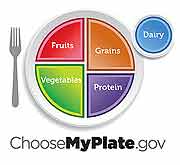Articles similar to this one will be featured in our new electronic newsletter, Driscoll Children's Health Notes. To subscribe to the newsletter, click here:
eepurl.com/brnI2vHealthy Diets Overview
Eating healthy is an important part of a healthy lifestyle. It is something that should be taught to children at a young age. The following are some general guidelines for helping your child eat healthy. It is important to discuss your child's diet with your child's health care provider before making any dietary changes or placing your child on a diet:
-
Eat 3 meals a day, in addition to healthy snacks in-between.
-
Increase fiber in the diet and decrease the use of salt.
-
Drink water. Try to avoid drinks and juices that are high in sugar.
-
Children under the age of 2 need fats in their diet to help with the growth of their nervous system. Do not place these children on a low-fat diet without talking with your child's health care provider.
-
Eat balanced meals.
-
When cooking for your child, try to bake or broil instead of frying.
-
Decrease your child's sugar intake.
-
Eat fruit or vegetables for a snack.
-
Decrease the use of butter and heavy gravies.
-
Eat more lean chicken, fish, and beans for protein.

Making healthy food choices
The My Plate icon is a guideline to help you and your child eat a healthy diet. My Plate can help you and your child eat a variety of foods while encouraging the right amount of calories and fat.
The USDA and the U.S. Department of Health and Human Services have prepared the following food plate to guide parents in selecting foods for children 2 years and older.
The My Plate icon is divided into 5 food group categories, emphasizing the nutritional intake of the following:
-
Grains. Foods that are made from wheat, rice, oats, cornmeal, barley, or another cereal grain are grain products. Examples include whole wheat, brown rice, and oatmeal.
-
Vegetables. Vary your vegetables. Choose a variety of vegetables, including dark green, red, and orange vegetables, legumes (peas and beans), and starchy vegetables.
-
Fruits. Any fruit or 100% fruit juice counts as part of the fruit group. Fruits may be fresh, canned, frozen, or dried, and may be whole, cut-up, or pureed.
-
Dairy. Milk products and many foods made from milk are considered part of this food group. Focus on fat-free or low-fat products, as well as those that are high in calcium.
-
Protein. Go lean on protein. Choose low-fat or lean meats and poultry. Vary your protein routine. Choose more fish, nuts, seeds, peas, and beans.
Oils are not a food group, yet some, like nut oils, contain essential nutrients and can be included in the diet. Others, like animal fats, are solid and should be avoided.
Exercise and everyday physical activity should also be included with a healthy dietary plan.
"Successful weight loss or management in children and adolescents occurs when the entire family is supportive," said Erica Gonzales, RDN, LD, CDE, clinical nutrition manager at Driscoll's Diabetes and Endocrine Center. "Reaching your goals is easy when every family member makes healthy food choices and increases physical activity as a unit. Making small positive changes frequently as a family is the key to success!"
Nutrition and activity tips
Here are some tips to follow:
-
Try to control when and where food is eaten by your children. Provide regular daily meal times with social interaction and demonstration of healthy eating behaviors.
-
Involve children in the selection and preparation of foods and teach them to make healthy choices by providing opportunities to select foods based on their nutritional value.
-
For children in general, reported dietary intakes of the following are low enough to be of concern by the USDA: vitamin E, calcium, magnesium, potassium, and fiber. Select foods with these nutrients when possible.
-
Most Americans need to reduce the amount of calories they consume. When it comes to weight control, calories do count. Controlling portion sizes and eating nonprocessed foods helps limit calorie intake and increase nutrients.
-
Parents are encouraged to provide recommended serving sizes for children.
-
Parents are encouraged to limit children’s video, television watching, and computer use to less than 2 hours daily and replace the sedentary activities with activities that require more movement.
-
Children and adolescents need at least 60 minutes of moderate to vigorous physical activity on most days. This helps to maintain good health and fitness and healthy weight during growth.
-
To prevent dehydration, encourage children to drink fluid regularly during physical activity and drink several glasses of water or other fluid after the physical activity is completed.
To find more information about the Dietary Guidelines for Americans 2010 and to determine the appropriate dietary recommendations for your child’s age, sex, and physical activity level, visit ChooseMyPlate.gov and 2010 Dietary Guidelines. Please note that the My Plate plan is designed for people over the age of 2 who do not have chronic health conditions.
Always talk with your child’s health care provider regarding his or her healthy diet and exercise requirements.